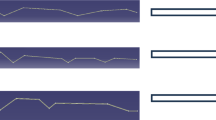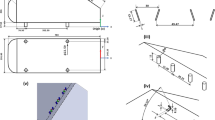Abstract
The Reynolds equations closed using the Menter shear-stress-transfer model modified with allowance for the curvature of flow line have been numerically solved jointly with the energy equation. The obtained solution has been used to calculate subsonic flow (at M = 0.05 and 5° angle of attack) past a thick (24% chord) Göttingen airfoil with variable arrangement of a small-sized (about 10% chord) circular vortex cell with fixed distributed suction Cq = 0.007 from the surface of a central body. It is established that the optimum arrangement of the vortex cell provides a twofold decrease in the bow drag coefficient Cx, a threefold increase in the lift coefficient Cy, and an about fivefold increase in the aerodynamic efficiency at Re = 105 in comparison to the smooth airfoil.
Similar content being viewed by others
References
A. V. Petrov, Energy Methods for Increasing the Lift of Airfoil (Fizmatlit Moscow, 2011) [in Russian].
A. I. Savitsky, L. N. Schukin, V. G. Karelin, et al., US Patent no. 5417391 (May 23, 1995); preceded by RF Patent no. 2015941 (1991).
P. A. Baranov, S. A. Isaev, Yu. S. Prigorodov, and A. G. Sudakov, J. Eng. Phys. Thermophys. 72 (3), 550 (1999).
A. Isaev, A. G. Sudakov, P. A. Baranov, and Yu. S. Prigorodov, Dokl. Phys. 46 (3), 199 (2001).
Control of the Flow past Bodies with Vortex Cells as Applied to Integral-Layout Flight Vehicles (Numerical and Physical Modeling), Ed. by A. V. Ermishin and S. A. Isaev (MGU Moscow, 2003) [in Russian].
S. A. Isaev, P. A. Baranov, N. A. Kudryavtsev, I. A. Pyshnyi, and A. G. Sudakov, J. Eng. Phys. Thermophys. 76 (4), 877 (2003).
P. A. Baranov, S. A. Isaev, Yu. S. Prigorodov, and A. G. Sudakov, Fluid Dyn. 38 (3), 387 (2003).
S. A. Isaev, P. A. Baranov, A. G. Sudakov, and V. B. Kharchenko, Thermophys. Aeromech. 14 (2), 169 (2007).
S. A. Isaev, A. G. Sudakov, P. A. Baranov, and N. A. Mordinsky, J. Eng. Phys. Thermophys. 80 (6), 1193 (2007).
F. De Gregorio and G. Fraioli, Proceedings of the 14th Int. Symp. on Applications of Laser Techniques to Fluid Mechanics (July 7–10, 2008, Lisbon, Portugal), pp. 1–12.
S. A. Isaev, P. A. Baranov, A. G. Sudakov, and A. E. Usachov, Tech. Phys. Lett. 40 (5), 417 (2014).
F. R. Menter, M. Kuntz, and R. Langtry, in Turbulence, Heat and Mass Transfer 4, Ed. by K. Hanjalic, Y. Nogano, and M. Tummers (Begell House Inc., 2003).
S. A. Isaev, P. A. Baranov, and A. E. Usachov, Multiblock Computational Technologies in VP2/3 Aerothermodynamics Program Package (Lambert Academic Publishing Saarbrucken, 2013).
S. A. Isaev, P. A. Baranov, Yu. V. Zhukova, A. E. Usachov, and V. B. Kharchenko, J. Eng. Phys. Thermophys. 87 (4), 1002 (2014).
Author information
Authors and Affiliations
Corresponding author
Additional information
Original Russian Text © S.A. Isaev, A.G. Sudakov, A.E. Usachov, V.B. Kharchenko, 2015, published in Pis’ma v Zhurnal Tekhnicheskoi Fiziki, 2015, Vol. 41, No. 11, pp. 103–110.
Rights and permissions
About this article
Cite this article
Isaev, S.A., Sudakov, A.G., Usachov, A.E. et al. Modeling an increase in the lift and aerodynamic efficiency of a thick Göttingen airfoil with optimum arrangement. Tech. Phys. Lett. 41, 561–564 (2015). https://doi.org/10.1134/S1063785015060061
Received:
Published:
Issue Date:
DOI: https://doi.org/10.1134/S1063785015060061




